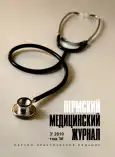Content of blood serum bone tissue metabolism indices in patients with prostheses instability after primary knee joint arthroplasty
- Authors: Galashina E.A.1, Ulyanov V.Y.1,2, Bondarenko A.S.3
-
Affiliations:
- Research Institute of Traumatology, Orthopedics and Neurosurgery, V.I. Razumovsky Saratov State Medical University
- Saratov Medical University “REAVIZ”
- V.I. Razumovsky Saratov State Medical University
- Issue: Vol 36, No 3 (2019)
- Pages: 5-10
- Section: Clinical studies
- URL: https://journals.rcsi.science/PMJ/article/view/11366
- DOI: https://doi.org/10.17816/pmj3635-10
- ID: 11366
Cite item
Full Text
Abstract
Aim. To assess the separate indices of blood serum bone tissue metabolism content in patients with instability of prostheses after the primary knee joint arthroplasty.
Materials and methods. The main group joined 40 patients with implant-associated inflammation, the comparison group – 40 patients with primary aseptic instability of prostheses, the control – 20 conditionally healthy donors. The blood serum hPTH and 25-OH Vitamin D content was determined using solid-phase immune-enzyme assay.
Results. Among the patients of the main group, blood serum hPTH concentration increased as compared with the control after1 and 12 months following the surgery and compared with each previous observation period; 25-OH Vitamin D level decreased compared with the control before the surgery, after1 and 12 months following the surgical intervention and compared with each previous period of observation. In the patients of the comparison group versus the control values, blood serum hPTH concentration elevated and 25-OH Vitamin D level declined after 1 and 12 months following the surgery and compared with the previous observation period 1 month later.
Conclusions. When estimating the blood serum hPTH and 25-OH Vitamin D content in patients with instability of prostheses after the primary knee joint arthroplasty, there were revealed multidirectional changes in their levels, showing bone tissue metabolic disorders.
Full Text
##article.viewOnOriginalSite##About the authors
Elena A. Galashina
Research Institute of Traumatology, Orthopedics and Neurosurgery, V.I. Razumovsky Saratov State Medical University
Author for correspondence.
Email: bib@sarniito.com
ORCID iD: 0000-0001-6209-9120
ResearcherId: V-9086-2017
http://www.researcherid.com/rid/V-9086-2017
кандидат биологических наук, младший научный сотрудник отдела фундаментальных и клинико-экспериментальных исследований, научно-исследовательский институт травматологии, ортопедии и нейрохирургии
Russian Federation, 148, Chernyshevskogo str., Saratov, 410002Vladimir Yu. Ulyanov
Research Institute of Traumatology, Orthopedics and Neurosurgery, V.I. Razumovsky Saratov State Medical University; Saratov Medical University “REAVIZ”
Email: v.u.ulyanov@gmail.com
доктор медицинских наук, заместитель директора по научной и инновационной деятельности; профессор кафедры хирургических болезней
Russian Federation, 148, Chernyshevskogo str., Saratov, 410002; 1 lit. A, Degtyarnaya sq., Saratov, 410076Aleksandr S. Bondarenko
V.I. Razumovsky Saratov State Medical University
Email: sarniito@yandex.ru
заместитель декана лечебного факультета и факультета клинической психологии
Russian Federation, 112, Bolshaya Kazachia street, 410012References
- Карякина Е.В., Гладкова Е.В., Пучиньян Д.М., Персова Е.А. Ремоделирование костной ткани после тотального эндопротезирования мужчин с коксартрозом и остепенией различной степени. Международный журнал прикладных и фундаментальных исследований 2017; 4: 511–515.
- Марков А.А., Сергеев К.С., Ситдиков И.Р., Марченко С.А. Развитие асептической нестабильности компонентов эндопротеза и миграции металлоконструкций после оперативного лечения пациентов с пререломами на фоне остеопороза. Медицинская наука и образование Урала 2018; 2: 127–130.
- Павлов С.Б. Участие паратиреоидного гормона и кальцитонина в регуляции метаболизма костной ткани при ремоделировании его нарушений. Вестник проблем биологии и медицины 2013; 2 (100): 185–189.
- Петрова Н.В. Диагностика имплантатассоциированных инфекций в ортопедии с позиции доказательной медицины. Хирургия позвоночника 2012; 1: 74–83.
- Сагаловски С., Шенерт М. Клеточно-молекулярные механизмы развития асептической нестабильности эндопротеза тазобедренного сустава. Травма 2012; (13) 1: 153–160.
- Слободской А.Б. Осинцев Е.Ю., Лежнев А.Г., Воронин И.В., Бадак И.С., Дунаев А.Г. Факторы риска развития перипротезной инфекции после эндопротезирования крупных суставов. Вестник травматологии и ортопедии им. Н.Н. Приорова 2015; 2: 13–18.
- Шепелькевич А.П. Современные подходы к профилактике и лечению дефицита витамина Д. Медицинские новости 2016; 6: 11–17.
- Christodoulou S., Goula T., Ververidis A., Drosos G. Vitamin D and bone disease. BioMed Research International 2013; 396541.
- Maier G.S., Horas K., Seeger J.B., Roth K.E., Kurth A.A., Maus U. Is there an association between periprosthetic joint infection and low vitamin D levels? International Orthopaedics 2014; 38: 1499–1504.
- Hardy R., Cooper M.S. Bone loss in inflammatory disorders. Journal of Endocrinology 2009; 201: 309–320.
Supplementary files






